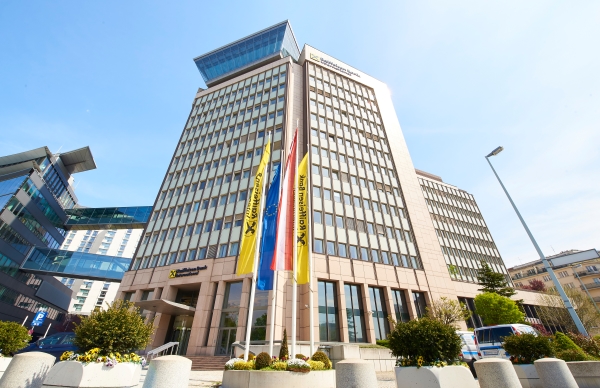RBI: Leading Austrian extends in green
Raiffeisen Bank International (RBI) cemented its status as the leading bank issuer of green bonds in Austria with the launch of its first green Tier 2 on 9 June, a €500m 12 year non-call seven deal that attracted some €2.8bn of demand, allowing for pricing 10bp inside fair value. Bank+Insurance Hybrid Capital spoke to Katarzyna Kapeller, head of asset liability management at RBI, about the trade and RBI’s funding and sustainability plans.

Why did you choose to go ahead with this €500m inaugural green Tier 2 transaction at this time?
We have a limited need for Tier 2 in 2021, €300m-€400m depending on business development this year. Our plan was therefore rather to issue the Tier 2 in the second half of the year, but we felt that — considering spreads and the level of demand — the market was just right for going ahead now, so we changed our plan and brought it forward a little.
We also did it sooner rather than later because we were concerned about there being more volatility in the second half of the year. The first half of the year has been something of an issuer’s market, partly due to there having been less supply, and our understanding is that more issuance can be expected in the second half of the year. Fears around inflation have already led to some rates volatility.
According to our breakeven analysis, spreads only have to widen 10bp-12bp before we make a saving by issuing now and taking a bit of negative carry for six to nine months. So we felt it was best to issue at these historically low spreads, rather than risk issuing later at a spread that could well be more than 12bp wider.
What determined the choice of the 12 non-call seven maturity?
We always like to do things a little differently to others. In the weeks preceding our issue, banks had been trending towards the shorter, 10 non-call five format due to the volatility in the market, with investors wanting to shorten duration. But when we approached the market, we felt that market sentiment was more positive, while the steepness between five and seven years was 16bp on the day. We therefore thought that we might attract better demand with a longer, 12 non-call seven issue, and our lead managers were neutral on this aspect. It turned out that investors were indeed quite positive on this.
You announced the transaction the day before launch — were there any particular messages you focused on in the premarketing?
We had a surprisingly high number of investors interested in calls. We had already done a lot of investor work on our Q1 numbers, but it turned out that investors still wanted to engage with us, particularly on the green aspect. Given that we do plenty of credit work with investors in between deals, we had also focused on the green aspect in the materials we had prepared, with a view to discussing this with investors. So we had a lot of calls in the afternoon after announcing the deal, and also investors coming back to us with questions during bookbuilding.
We are a small bank when compared against the big players, which is why we tend to take a 1.5 day approach to new issues and in general don’t favour intraday execution. This also takes into account the distinctive geographic distribution of our portfolio, taking in central and eastern Europe, as we need to give investors a bit more time to do their work and arrange or increase limits. Plus this time we also had the green aspect to discuss.
How did investors respond to the transaction?
We received an unusually large amount of positive feedback on the day we announced the trade, with concrete indications on spreads and order sizes. So when we entered the market on the day of launch, we already had quite a good feeling about the trade, but we were still quite surprised by the very positive dynamic that we had in the bookbuilding process — after 90 minutes, we were already above €1bn, which is exceptional for our name.
Did the pricing pan out in line with what you were targeting?
We were hoping to land at 170bp, but in the end our leads were convinced that 160bp was on the table because the order book was so strong, so we went ahead with pricing it at that level. We do not want to be greedy, but to leave a little room for performance, and the new issue has worked very well, tightening some 5bp afterward. I believe our name had been trading too wide in the secondary market beforehand, which further explains how we were able to price inside our initial expectations.
Did the less favourable market contribute to the choice of green for this Tier 2 trade?
We were convinced that the green flag would support the trade, although it is difficult to say now how much it affected the outcome.
We started issuing green bonds in 2018 and our first green bond matures the day after the value date of this new Tier 2. Our debut green bond was in senior format, but as we do not need senior funding at this point in time, it made sense to issue the next transaction, whatever the format, in green. In doing so, we have maintained our status as the biggest bank issuer of green bonds in Austria.
I would not issue an AT1 in green, but to me, issuing Tier 2 in green shows more of a commitment to sustainability because it’s longer dated — in this case, it shows a commitment of at least seven years. And as an issuer, I feel that the pricing benefit is higher in a higher beta product.
So the choice of green was both an economic and a strategic one.
What can you tell us about your funding plan for the year and how it is going?
As indicated earlier, we are done with Tier 2 for this year. On senior non-preferred, we do not have any plans for this year, at least, because as a multiple-points-of-entry group, in the Austrian resolution group we are quite comfortable with the subordination requirement. Senior preferred might be a topic for this year, depending on business development and other factors. Currently business looks better than we anticipated at the beginning of the year, and depending on further development, we might be active in senior in private placements or even in bigger size.
Coming back to green, you’ve been issuing in that format for some time, and you mentioned that you discussed green with investors — are there any changes on the green side?
No. We still use the framework from 2018. Why? The first reason is that although the EU Taxonomy is nearly done, it is still not clear how people should implement it in their frameworks. Many issuers have therefore not yet updated their frameworks, and we also felt that we should wait to see how it is treated in the market.
Secondly, two years ago we implemented internally a social bond framework aimed at supporting social assets. It is not a formal framework, but we would like to combine it with the green one. So instead of making a small update to the green framework, we would rather combine green and social in a bigger update under an umbrella framework.
We have seen interesting green issuance from other RBI group members recently. How is that coordinated among you all?
We have a good and clear coordination and communication regarding the issuance calendar — who has plans to do what, when — with the neighbouring team in the Austrian head office that covers the network banks. In this case, the network banks had plans that were more fixed and had reserved issuance windows, whereas we stepped in rather opportunistically. The recent Romanian issue was in the domestic currency and placed in Romania, and these local bonds can be timed more independently as they do not affect the international issuance plans of other group members. But when it comes to the Czech or Slovak international bonds that were issued recently, then we are very closely coordinating our activities.

